Who Was the Founder of Happenings an Attempt to Use Real Materials and Location as Art?
Emerging from the theatrical elements of avant-garde movements, such as Dada and Surrealism, the happening was the predecessor to operation art. Its influential figures were interested in bridging the gap between life and art. In most cases, happenings occurred in the environment or as installations created in a gallery. Relying on different elements, such as light, audio, and slide projections, the audience participation was of crucial importance. Public's involvement for the creation of the piece of work added an chemical element of take a chance. Due to information technology, every time a piece was performed or exhibited was unique. Repetition of the aforementioned action was not possible, and as such happenings helped to define a new thought of the temporality of an artwork. This period, with its events besides encouraged the result of the 'death' of painting.
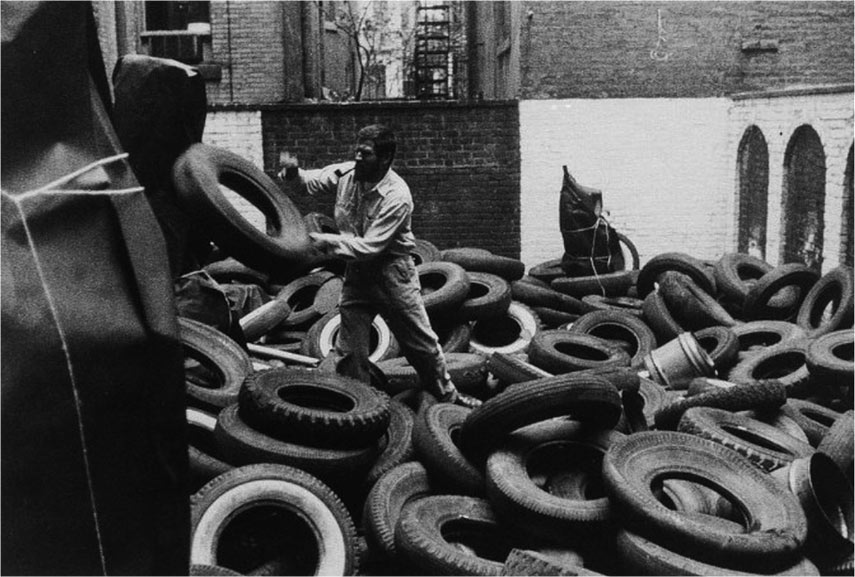
How Does Ane Define a Happening?
What started every bit a rebellion, initiated by Futurists and Dadaists in the 1910's and twenty's later created operation art. These advanced artists introduced their revolutionary ideas through diverse acts. Through the actions of reading their manifestos and poetry on stage what we know every bit a happening was born.
The coining of the term happening nosotros owe to an artist and lecturer Allan Kaprow. In spring 1957, Kaprow visited George Segal'south subcontract. It was due to his attempt to define and describe the art produced at this place, that the term was born[i]. In printed publication, the term was used in his writings The Legacy of Jackson Pollock. Unlike the ideas of the famous critic Cloudless Greenberg, Kaprow was less interested in the art object and more in the process of creation. His ideas concentrated on the production and promotion of art that used everyday life and everyday objects. Rebelling against the technical aesthetics of Abstract Expressionism, Kaprow emphasized the importance of artist's action and the process of cosmos above the finished piece of work.
The challenge to the history of an art object, the happenings accomplished past important innovations apropos time. As a temporal experience, events forming the happening could not be exhibited in a traditional sense. The merely artifacts that remained were photographs or oral stories. As such, happenings toyed with the very nature of art and created its new category[2].
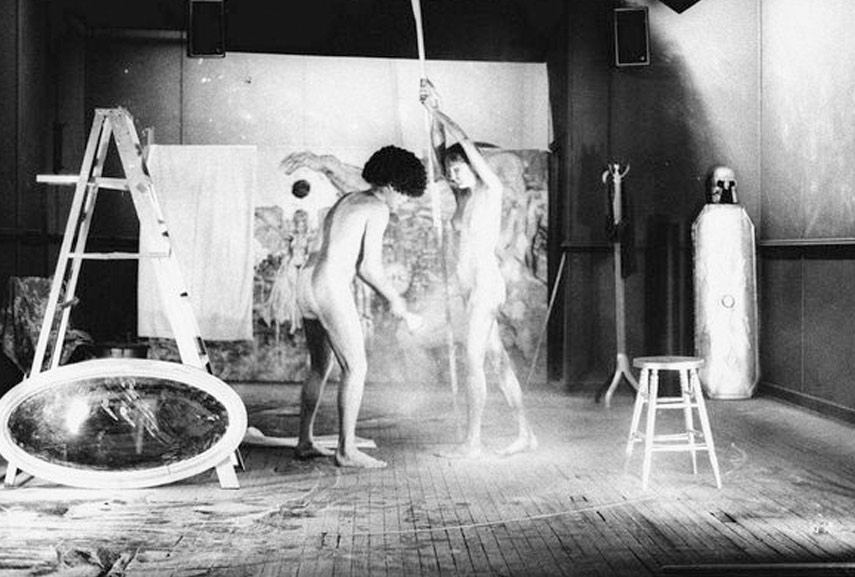
The Style of Happenings
A notion of shared style of happenings organized by the artists did not exist. Taking the theatrical elements of the Futurists, and the Dadaist rebellion to what is considered equally art, the actions varied in size and sophistication. Similarity did exist between this group and the Fluxus, but the major difference between the two was seen in the organisation and complexity of the happening[3]. The events of a Fluxus grouping were closer to an thought of theatrical improvisation. But, in relation to the afterward developments and the birth of performance art, the happenings were unique equally they relayed more than on adventure. The repetition and the theatricality of such art, the happenings did non possess.
Depending on the artist's sensibility, happenings were both large-scale and elaborate, and also intimate. Where they would take identify too varied. With the ability to be enacted anywhere, sometimes they were staged inside a gallery, just also on the streets, theater, farms, or fifty-fifty in a cave.
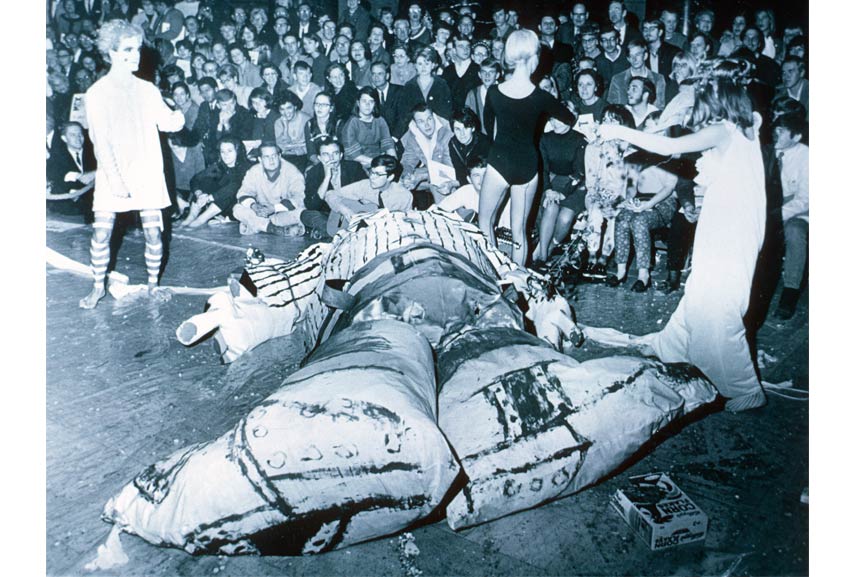
The Virtually Famous Happenings
The absence of boundaries between the viewer and an artwork, along with the celebration of chance and the audience participation blurred the boundaries between art and life. Artists such as Allan Kaprow, Robert Whitman, and George Brecht, needed to insubordinate against the act of painting and wished to create a new space for fine art and for art'south public. Happenings were reflection of a spirit of i particular fourth dimension in the history of the 20th Century. As students were attacking the institutions during the 1960s, every bit philosophers of that menses challenged some basic ideas of classic philosophy, so were many artists participating in an open up attack confronting "conventional art". Happenings from the tardily 1950s and 1960s, peculiarly in the Us, are considered as the nearly famous examples of this important art menses. Although the line separating performance art and happening is often invisible, in the listing of the most famous happenings, we won't present those ones that took place after 1970, when operation and conceptual art already had a status of legitimate part of contemporary art.
How to Make a Happening
Allan Kaprow - 18 Happenings in half dozen Parts, 1959
Presented at the Reuben Gallery in New York in 1959, Allan Kaprow's xviii Happenings in vi Parts is a performance divided into six parts, each of them containing iii happenings occurring all at once. It is based on the creative person's action painting grooming and a very scripted score, involving the audience in an unprecedented way.
The instruction cards provided to the participants stated, among other things:
The showtime and cease of each volition be signaled by a bong. At the end of the performance two strokes of the bell will be heard...At that place volition exist no applause after each fix, simply y'all may applaud after the sixth fix if you wish.
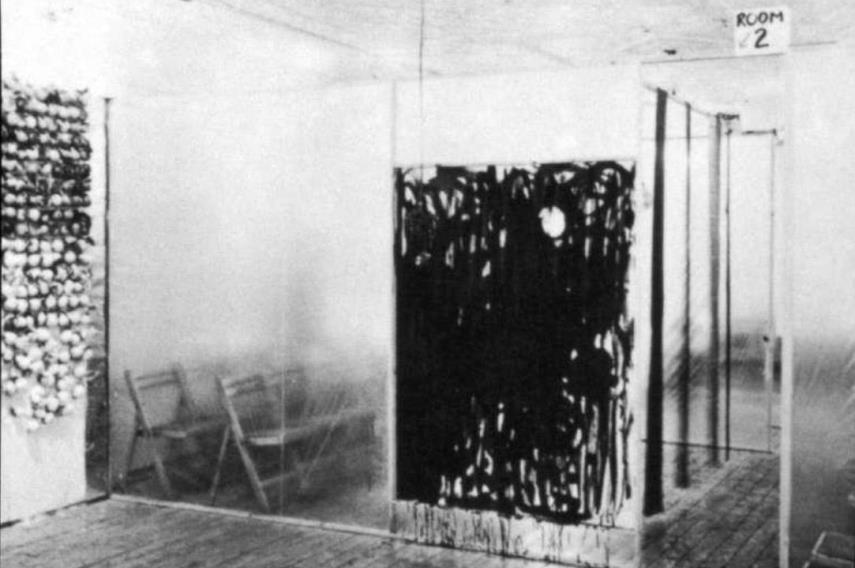
Robert Whitman – American Moon, 1960
I of the near notable American operation artists is Robert Whitman. He was 1 of the near important figures of American happenings scene, particularly in New York City. Whitman'due south piece American Moon was performed at the Reuben Gallery in New York. The piece consisted of vi paper tunnels that radiated outwards from the performance area in which the audience would sit down to watch piles of cloth being moved accompanied past diverse sounds. Curtains were hung in front of the tunnels and a movie was projected on them. Still, performers were moving which was causing distortions in the movie. At the finish of the screening the tunnels were ripped downward and the curtains removed. As figures began to roll effectually the floor, with heavy lights, someone swung on a trapeze with a sound of a vacuum cleaner in the back. Whitman chosen these types of works "abstract theaters". As Randal Packer explained the work: This is not anything like traditional theater, but rather more like a sculptural environment, with the performance integrated into the infinite.
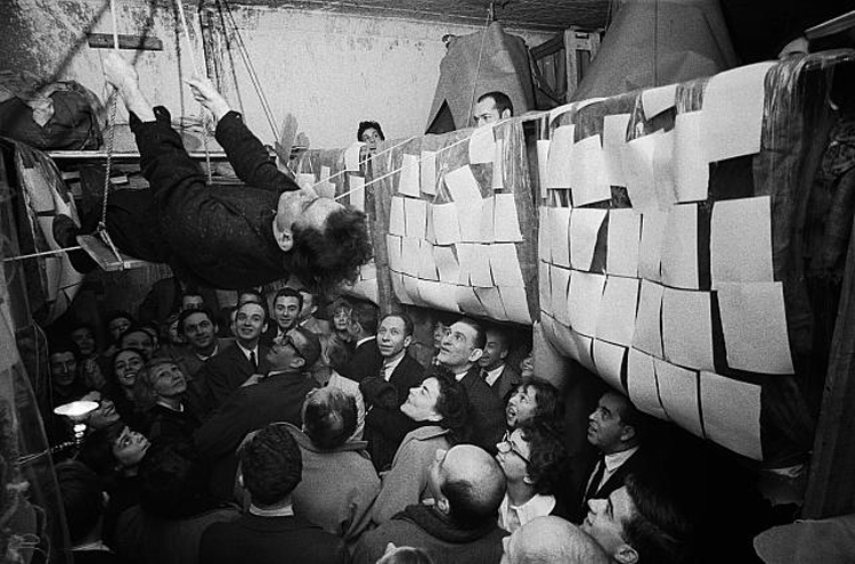
Allan Kaprow – Yard, 1961
Allan Kaprow was a pioneer in establishing the concepts of performance fine art, and one of the chief theoretician of the concept of "happening". Yard was a piece conceptualized as a response to the Jackson Pollock'south "drip" paintings. The piece involved the random scattering and piling of tires over the floor, while the visitors or participants were invited to climb over them. What the pigment was for Pollock, the tires were for Kaprow in this slice. The terminal result of the happening is a iii-dimensional "replica" of Pollock's action painting. The piece has been recreated several times and every time an original artwork was created – a completely new pile of tires.
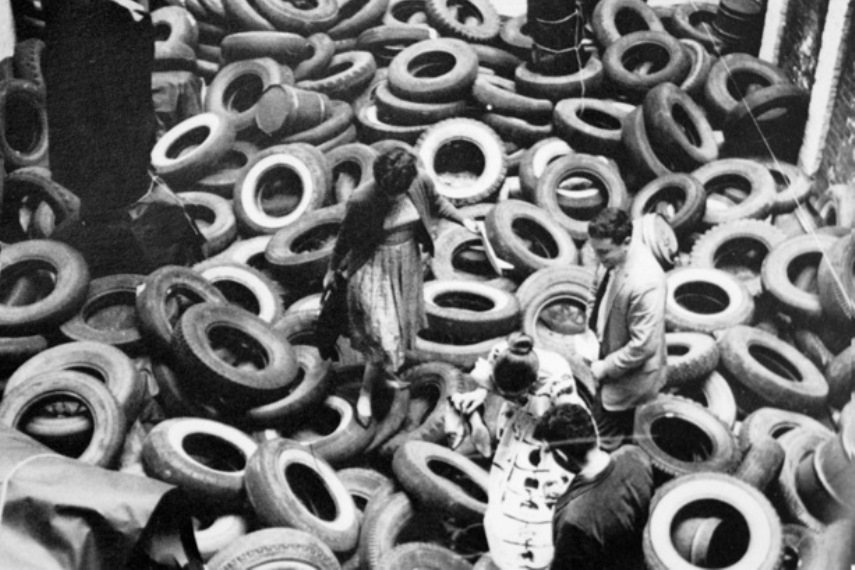
Robert Watts – Stamp Vendor, 1961
Postage Vendor past Robert Watts might be chosen an "unusual" happening, considering the last consequence of the piece is an object. This happening involves stamps that artist created and placed inside of actual postage dispensers that Watts took from the U.s. Post Office. The stamp dispensers were eventually put in an exhibition space, and viewers could purchase the stamps by placing coins in the coin slots. But, what was the difference between Watts's stamps and the original ones? Watts put different images on stamps, such as nude women or gas cans. This is a unique, and unusual happening because the viewer did not interact with the artist, but with objects. In improver, the piece was criticizing traditional art objects, because every viewer after the bear witness would exit with an original piece of art – Watts' stamps that were bought for less than ten cents.
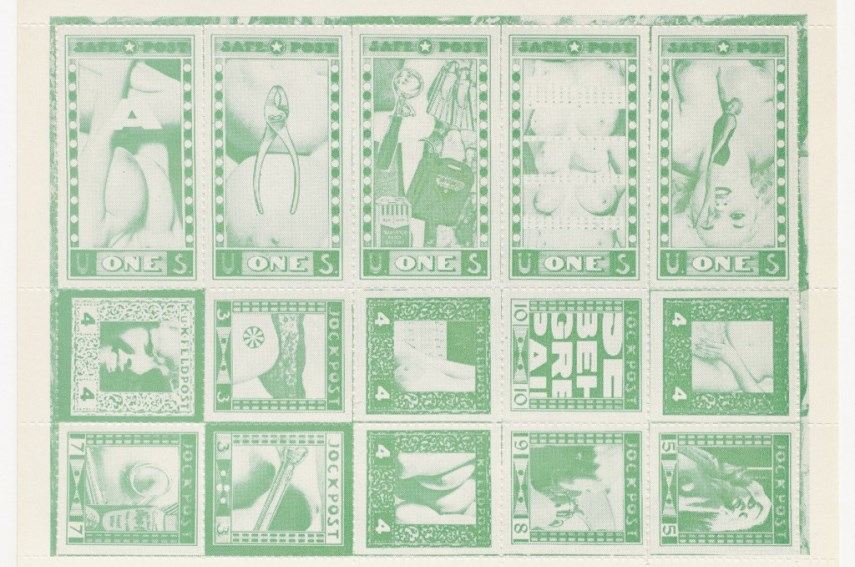
Dick Higgins - The Thousand Symphonies, 1968
One of the cardinal members of Fluxus, George Brecht was also a prominent composer and printmaker. He also conceptualized one of the most recognizable happenings in the 1960s that is called The Thousand Symphonies , and that has many elements of performance art. This piece is a portion of compositional paper that has been shot with a machine gun at a rifle range. The bullet holes eventually became notes that were played by orchestra. The original orchestra performance of The K Symphonies was conducted by Philip Corner at Douglass College, the women'southward residential higher at Rutgers. As in every happening, hither we also see the elements of chance or unpredictability. Information technology is manifested past the unpredictable placements of the bullet holes besides as the decisions made by the conductor when the slice was performed. A huge influence on this work had Futurist and Dadaist work that were inspired by music.
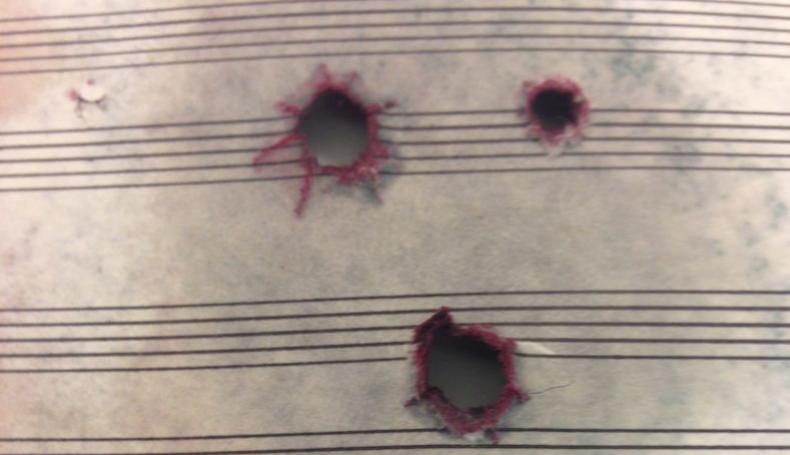
Allan Kaprow – Fluids, 1967
This is the third happening by Allan Kaprow in this list, but his contribution to the great influence of happenings to performance and conceptual fine art is simply besides of import to be ignored. His slice Fluids from 1967 gathered local residents in and around Pasadena, California in society to build huge water ice structures in various locations beyond the town. This commonage action resulted in melting of the ice symbolizing the intrinsic nature of human labor – the outcome is nada. This happening is one of the most striking attacks against traditional art. As man labor and its products annihilate due to processes of capitalism and consumerism, and then do art objects as well – eventually they become nothing.
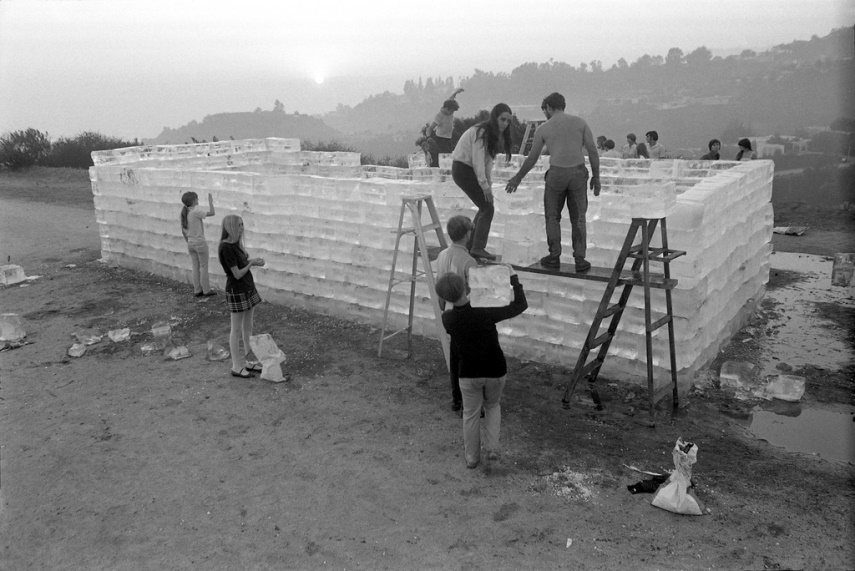
Do We Have Happening Today?
Happenings climaxed with the notorious Yam Festival in 1963. This one-month series of events were organized at George Segal'south farm, and other locations in and around New York City. After this issue, happenings slowly started to dissolve equally other art theories became dominant. Influencing conceptual art, performance art, torso art, and feminism fine art, happenings and their original ideas towards the time and infinite human relationship continued to shape the art of the 20th-century.
Today, in famous festivals, such as Burning Man one can sense the importance of the audition participation that was strongly promoted by the happening artists. This we can too chronicle to the Wink Mob and Oregon Country Fair events as well. Notwithstanding, we must understand that the most of import legacy happenings left u.s.a. with is the globe of operation fine art. In this arena, diverse artists merge the real life and the virtual, combine theater with the visual art, and examine the limits of the human body. Such experimentation was more evident in the performances of Ulay and Marina Abramovic. Nevertheless, the true spirit of happenings, that emphasized interaction and embodied experience is today more apparent in music festivals and other similar events than in the world of contemporary art. In its eclectic nature, contemporary art today holds a legacy of almost every influential modern art movement. Shaped by the revolutionary ideas of the past, happenings today linger in their original ideas of audience participation, and the ephemeral quality of the artwork they left us with.

Editors' Tip: Critical Mass: Happenings, Fluxus, Performance, Intermedia, and Rutgers University, 1958-1972
The book Disquisitional Mass chronicles the events and performances that happened at the influential Rutgers University. The Fluxus motion, happenings, and performances are presented in this volume through various photographs that depict the organized events. Alongside the photographs are also essays by the famous art historians and scholars that further illustrate this dynamic motion. Seen to influence a new understanding towards gender bug, sex, race, and state of war, the happenings illustrated in the volume showcase an of import part of American history also. If y'all ever wanted to learn more most the imperceptible works on the Rutgers and in the New York Urban center this book is a must take.
References:
- Sandford, R., M., Happenings and Other Acts , Routledge, 1995
- Kapprow, A., Essays on the Blurring of Fine art and Life , University of California Printing, 1993
- Hopkins, D., After Modern Art 1945 - 2000, Oxford University Press, 2000
- DiTolla, T., and Foundation Contributors, Happenings, The Art Story
All images used for illustrative purposes only. Featured image: Marta Minujín participating in the destruction of collective work in Paris, 1963, via Wikipedia.
Source: https://www.widewalls.ch/magazine/happening-happenings-performance-art
0 Response to "Who Was the Founder of Happenings an Attempt to Use Real Materials and Location as Art?"
Post a Comment